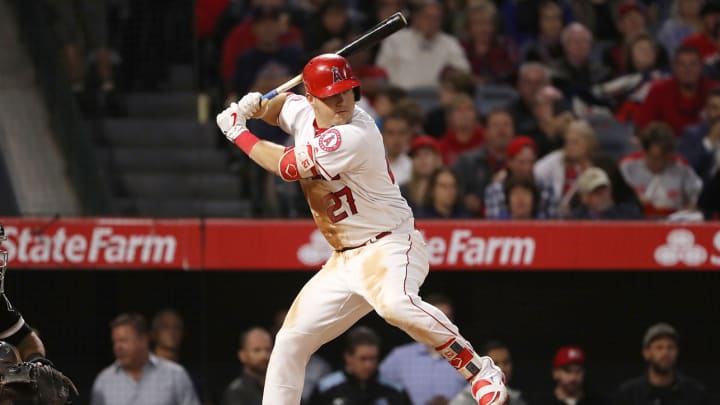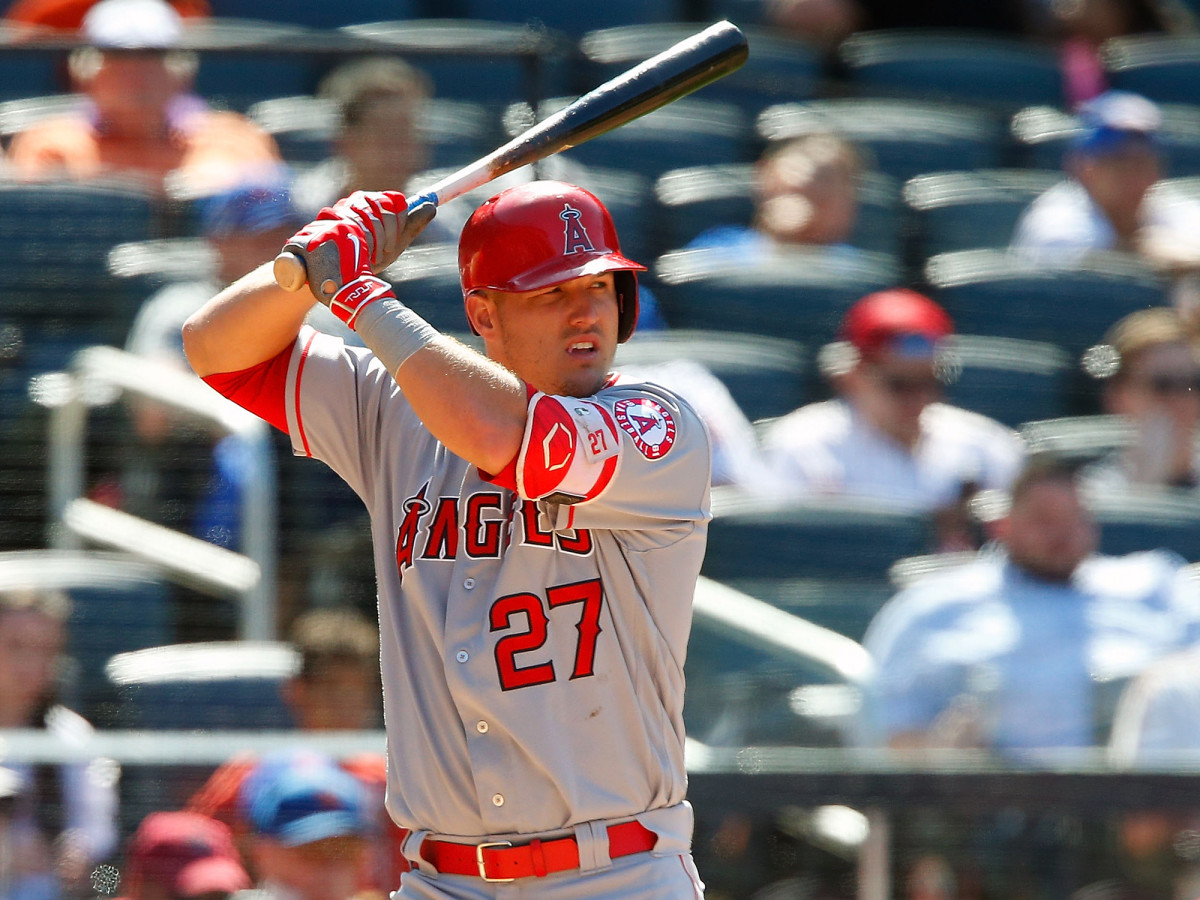Somehow, the remarkable Mike Trout is only getting better as he builds a historic season

As Angels centerfielder Mike Trout walked to the plate at Citi Field last Saturday night in the ninth inning with the bases loaded, no one out and his team trailing the Mets by three runs, a thought crossed New York manager Terry Collins’s mind for a brief but serious moment. He could have closer Addison Reed, who’d already given up a walk and an RBI single to the first two batters he’d faced, attempt the most difficult task you could ask of a pitcher in 2017: retire the best hitter in the entire world with no margin for error. Or, Collins mused, he could opt out of that unappealing scenario entirely by doing something that has happened in a game just twice in the past 72 years: order an intentional walk with the bases loaded.
“The first thought is, I’d almost rather walk this guy than give him a pitch to hit,” Collins said after the game. “Those are the kind of situations where you look back at the time when Buck Showalter walked [Barry] Bonds with the bases loaded [in 1998] rather than pitch to him. It was the same feeling.”
This is the rarefied air in which Trout now resides—alongside Bonds, whose strike zone mastery and prodigious power had few equals in baseball history, and Josh Hamilton, who was en route to an AL-high 130 RBIs when he got the same treatment from then-Rays manager Joe Maddon in 2008. And although Collins ultimately chose to pitch to Trout (he flew out to rightfield to drive in a run in New York's 7–5 win), his dilemma reflects a fascinating question that the rest of the league has to confront: Has the best player in baseball somehow gotten even better?
“I played with [Josh] Donaldson in his MVP year [in 2015] and [Paul] Goldschmidt when he should have won an MVP [in '13], and those were pretty special, but this is a different level,” says Angels infielder Cliff Pennington. “I’m just glad he’s on my team.”
Fame Game: A dozen Cooperstown-bound stars and the most star-studded matchup ever
The numbers have always been on Trout’s side, but they are patently ludicrous in 2017. Through 43 games, the 25-year-old reigning AL MVP is hitting an astonishing .347/.466/.760, and his 15 home runs are tied with Yankees slugger Aaron Judge for the most in the majors. Trout leads the AL in batting average and total bases and is first in all of baseball in on-base percentage, slugging percentage, OPS and OPS+ (233). He's also third in the AL in RBIs, just two behind co-leaders Miguel Sano of the Twins and Nelson Cruz of the Mariners. All of which means that Trout has a chance to join Red Sox legend Carl Yastrzemski, who did so in 1967, as the only players since 1948 to win the traditional Triple Crown and the slash-stat triple crown in the same season.
Not surprisingly, Trout is also first in Baseball-Reference.com's Wins Above Replacement (3.4, which matches his MLB-high production in the WAR calculations of Baseball Prospectus and FanGraphs), a category he has topped the AL in for each of his first five seasons. (The only player to lead a league six years in a row? Babe Ruth.) Since the start of May, Trout has reached base in 37 of his 74 plate appearances and hit eight home runs. He’s already been intentionally walked an MLB-high nine times—his career high is 14, set two seasons ago—including twice in three games against the Mets (once in the first inning of a 0–0 game) and six times this month. And a year after being caught seven times in 37 stolen-base attempts, he’s been thrown out just once in 10 tries this season.
It’s easy to present stat after eye-popping stat with regards to Trout—here's a fun one: With 51.9 career WAR, he’s already passed 46 enshrined Hall of Fame hitters in that category—but it’s harder to explain how someone so young has become so good with such consistency. It's even harder to figure out how that player could possibly improve. Trout can’t point to anything specific. “Just being consistent, putting the ball in play more, squaring up balls,” he said. His teammates, meanwhile, struggle to explain Trout’s expanded brilliance, if only because they’re so used to it.
“On a day-to-day aspect, we don’t really notice him getting better,” says first baseman C.J. Cron. “It feels normal to me. Every recollection I have of him, he’s been at an MVP level, and he’s not slowing down.”

There has been one notable change in Trout’s swing rate from last season: He's taking more cuts overall, particularly within the strike zone, and as The Ringer's Ben Lindbergh points out, he's gotten more aggressive on first pitches. But aside from that adjustment, there's not much else to explain his uptick. He’s not hitting the ball any harder, his launch angle hasn’t substantially changed, and there’s been no swing overhaul. Asked for his opinion, manager Mike Scioscia posited that Trout’s improvement is tied to the experience he’s gained over his first five years. “He’s absorbed information and he’s become a better player, learned how to apply his tools,” he says.
That tracks with the established belief that a player gets better over time and with regular exposure, particularly as he ages into his peak (usually between 26 and 30 years old). But you wouldn’t expect that to apply to Trout, because he’s already broken so many of the of the game’s inviolable rules. A player isn’t supposed to handle the majors with such ease so soon. A player isn’t supposed to be Hall of Fame-worthy before he’s old enough to rent a car. And a player isn’t, after starting his career by performing like the peak version of Willie Mays, supposed to find a level beyond that. With someone who’s already as good as Trout is, there’s no explanation that can make sense of the idea of him getting better, because that idea is completely absurd.
But if there’s one thing that’s likely at the heart of Trout’s potential improvement, it’s the same thing that has made him this good in the first place: the acceptance that in baseball, you must confront and conquer failure with crushing regularity. What makes Trout special isn’t just how fast he can run or how far he can hit the ball or how easily he scales a wall to rob a home run; it’s how he can survive all the low moments in between.
“A lot of guys would let an 0-for-4 [game] get to them, but Trout will show up the next day like nothing ever happened,” Cron says. “That’s the mentality that takes him to the next level. He never dwells on one at-bat. He’ll sometimes laugh about it, and then it’s onto the next one.”
Forget velocity, the curveball's resurgence is changing modern pitching
“I just try to keep it as simple as possible,” Trout says. “When you start looking at too much video [and stats], you start making your mind go crazy, and that’s where you get in trouble. You’ve just got to go up there and see [the pitch] and react.”
Trout’s success is built on how easily he turns both the brilliant and the difficult into the mundane. He reduces the sport to its most simple components—a laser-like focus on a single at-bat or a single game—and executes with ruthless efficiency. The mentality needed to operate that way is hard to comprehend, just like the numbers he produces. It separates Trout from even the veritable superhumans who are the best of the best in the game.
That kind of success can be hard to appreciate, particularly given the way Trout packages it: with little flair. He hits booming home runs, but he doesn’t produce moonshots on the regular. He is a superb baserunner, but he doesn’t have ridiculous speed. He is an excellent defender, but he doesn’t dominate highlight reels. The platonic Mike Trout highlight is him taking a perfectly placed inside fastball and ripping it to the opposite field on a line, or going first to third on a single up the middle, or running down a deep fly ball without having to dive for it. His seemingly effortless excellence is borne out of an unrivaled combination of skill and consistency, and his ability to maintain that consistency makes the possibility of him turning his white-hot start into a season for the ages a very real one.
Jason Heyward on his hitting struggles and how a yoga instructor is helping him find his way
A player chasing this kind of immortality should be a household name, but Trout isn’t. He’s reluctant to step into the spotlight or expand his personal brand while being almost comically reserved (though polite) with the media. Close to 75% of his at-bats this season will come after 10:00 p.m. ET and won’t be on national television. The team around him is mediocre at best: Collins was able to entertain the idea of a bases-loaded intentional walk because the man behind Trout in the order that night, Luis Valbuena, is hitting .167 in 54 at-bats this season; he popped up in foul territory after Trout’s sacrifice fly.
The rational thought is that no man, no matter how good, can keep this up. But Mike Trout, the man who can do it all, routinely defeats rational thought. “If there’s something he’s not good at,” Pennington says, “I haven’t found it yet.”
